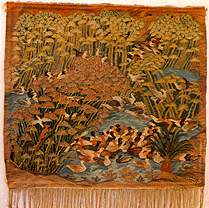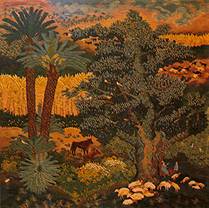|
JOURNEY IN CREATIVITY
In order to understand how Ramses Wissa Wassef's novel venture
first took shape, it is valuable to follow the background
from which his ideas emerged.
 Papyrus - 1982
Papyrus - 1982 |
Ramses' deep interest in crafts can be traced to 1935, the
year that he returned to Egypt after the completion of his
studies. After eight years of living abroad, Ramses had returned
home in search of his culture with a determination to find
his place in its milieu. It was during the early years of
his return that he would take long walks through the old quarters
of Cairo. This particular district had been one of his favorites,
and it was there that he would wander through the narrow streets
and alleyways studying the buildings and speaking to the dwellers.
Outings in the old quarters also gave Ramses the opportunity
to encounter a number of craftsmen - weavers, potters, glassmakers,
and stonecutters alike - all inheritors of ancient traditions
and techniques. From these meetings he gained a knowledge
of skills that he eventually went on to use in his own architectural
work. Perhaps more importantly, his contact with these craftsmen
gave him the opportunity to study their situation closely.
Before long he realized that eventually these crafts would
vanish. Although these men were honest tradesmen, no new force
or creativity could be expected from them, and many of the
craftsmen he knew had died without having trained any apprentices.
These facts deeply effected Ramses and thus led him to reflect
on man's condition in the age of the machine and to discuss
the problem with his colleagues. He later wrote, "Everywhere
I found reservations in the face of increasing mechanization,
and the damaging discipline of abstract education to which
human beings are subjected during the most important period
of their lives-when they are becoming people."
For Ramses Wissa Wassef, once broken a tradition could not
be renewed. By using their own training methods, craftsmen
used to hand down their skills from generation to generation.
Currently used methods only resulted in routine mass production.
Modern educational systems, he felt, could not form craftsmen.
On reaching this point in his thoughts, he made the following
conclusions:
1) Artistry and craftsmanship are aspects of a single activity.
2) A demand exists for handicrafts, which at present is not
satisfied by either art or industry. Therefore, production
by craft methods can still be economically viable.
3) The creative energy of the average person is being sapped
by an abstract conformist system of education, and by the
extension of industrial techniques to every field. But while
the machine threatens to reduce human beings to passivity,
it also frees them to develop a potential that will wither
away if it does not find real fields for action.
4) The capacity for artistic creating exists in every child,
but it needs fostering and protecting against superficiality.
"The idea or feeling", Ramses
later wrote, "which ultimately drove
me to act, was to all appearances a very Utopian one...
|

|
When I try to formulate it however,
all sorts of cliches and common place ideas creep in. I had
this vague conviction that every human being was born an artist,
but that his gifts could be brought out only if artistic creating
were encouraged by the practicing of a craft from early childhood."
It was in 1941 that Ramses Wissa Wassef was asked to build
a small primary school in the old quarter of Cairo. This architectural
project gave him just the educational opportunity he had been
seeking. Wanting to provide a fairly simple technical process
as a vehicle for the children's efforts, he asked the committee,
which had initially commissioned the building, if it were
possible to let him teach weaving to the children after school.
Here, it is interesting to note that Ramses knew little of
the practical aspects of weaving before taking on the project.
In preparation, he read up on the subject at length and experimented
with the craft on his own. He also learned how to prepare
and use natural dyes; a practice he felt would give more control
over the colors produced. Since that time, only natural vegetable
dyes have been used on the wool that goes into the tapestries.
Admirers of his achievement frequently ask why Ramses Wissa
Wassef chose weaving as the medium for his experiment. Here
it is fitting to include the answer, in his own words:
" I chose it, (weaving) because
I saw it as a way of getting the children to produce images
by means of a craft technique, of starting them off on an
activity that involved a union of body and soul, a balanced
combination of manual work and artistic creation. This could
have been done in other ways, but in fact the technique had
to be chosen carefully. Drawing, painting and modeling are
not craftsman's trades, while mosaic work, ceramics, wood,
stone and metalworks do not present the same balance between
art and craft. I felt that tapestry-making would provide the
happy medium for the experiment I was planning."
Having once obtained permission to set up a few weaving looms,
Ramses then brought in a local weaver to introduce the technique
of weaving. Using high-warp looms, which are known to resemble
the very earliest looms, and which leave the artist the greatest
freedom in creating his designs, the children began their
work. At that time the warp consisted of twisted cotton, but
later linen thread was substituted. The weaving was done with
local wool, which Ramses had taught the children to dye.
 Fayoum - 1982
Fayoum - 1982 |
Although Ramses soon found the results to be satisfying,
he himself knew that the experiment needed more time and that
it would have to be carried on further. The committee, however,
did not find the project commercially feasible, and Ramses
quickly realized that it could not continue at the school.
It was at that point that he asked some of the young weavers
if they would like to work with him privately; and so it was
in the late 1940's that three of them went to work at his
home.
By 1949 Ramses was faced with a great responsibility. These
children had now reached their mid-teens and their futures
rested in his hands. If they were to continue weaving as a
career, they would need a proper environment and circumstances
in order to pursue their work. On the other hand, if they
would not be weavers, they would have to go out in the world
to find other livelihoods. Observing that the children's results
were superb, Ramses knew that not to pursue the experiment
would be a great waste. It was with considerable courage that
he finally chose to help these children to become professional
weavers.
|
|